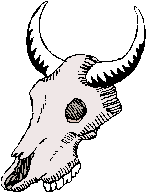Legend: Farmer who cannot sell his cattle at auction due to their drought-caused emaciated state kills them and himself.
Example: [Collected on the Internet, 2002]
Here's a story that shows how bad the drought has been: A rancher in Alberta brought his cattle in to auction because he could no longer afford to feed them. They were so thin and sickly looking he could not find a buyer. The man went back to his farm, shot his cows, then himself. |
Variations:
- Sometimes the distraught rancher cannot find a buyer; other times he succeeds, but gains so little from the sale that it wasn't worth his time to have sold the animals.
- In 2002 this story was being told as a true and recent occurrence in Alberta and Saskatchewan.
Origins: The summer of 2002 visited upon Canada's western provinces a horrific drought. Normally lush prairie parkland was turned brown by the summer's heat and the absence of rainfall. An area stretching from Fort McMurray, Alberta, through Edmonton

and on past Saskatoon was parched, some sections for the third or fourth year. Large tracts of land were the driest they had been in
Crops shriveled and were not worth the trouble of harvesting. Fields of hay that looked like they would survive were few and far between, and pasture land was so severely affected that Alberta faced the loss of up to a third of its cattle. What feed was available was being sold at astronomical prices, $4,000 for a load that would have cost about $1,600 in a more normal year.
Many ranchers sold off their breeding stock because they could not continue to feed their herds. Auction houses were handling almost ten times their usual volume for mid-summer, most of what was going on the block being breeding cows and their calves, animals who would in normal times never be sold. Without that stock, the ranchers would not easily be able rebuild their herds when the drought was over.
Difficult times spawn their own legends, which was the case here. The oppressive aridity inhabitants of that region endured gave birth to a rural legend about a rancher made so despondent by his inability to sell his cattle for a fair price that he slaughtered them then turned the gun on
himself.
Though the story had been loosed in many directions, there was no particular reason to believe it had any grounding in fact. Alberta Agriculture had been unable to confirm the story, said spokeswoman Terry Willock, who had heard it set in at least three different towns. Neither had Staff
Why the story, then? Folks draw comfort from tales that show no matter how bad they have it, someone is weathering far worse. A rancher who has had to deal with the grief of seeing his breeding stock (which represents both years of hard work and the future of his operation) sold to the slaughterhouse at least could draw upon the realization that he was not as bad off as that fellow who killed himself over it.
The "despondent rancher" legend also gave voice to the anxiety cattle ranchers in the Canadian west were experiencing. It captured, in the form of a story, the extent of the desperation these folks were having to deal with.
Hotlines were set up to help western farmers and ranchers address their growing sense of despondency, but more importantly the Alberta government put a new
In 2010 most of the 2002 legend came true on a farm in
Barbara "loss cause" Mikkelson
Last updated: 29 September 2010
 Sources:
Sources:
